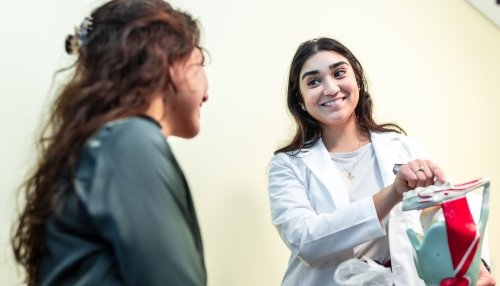Normal swallowing involves the acceptance, preparation, and movement of food and/or liquid from the mouth to the stomach while protecting the airway. Disordered swallowing, or dysphagia, affects both children and adults due to a number of injuries and/or diseases. In adults, neurological diseases such as Parkinson’s disease, dementia, myasthenia gravis, multiple sclerosis, and muscular dystrophy may result in swallowing difficulties. Additionally, neurological injuries such as strokes and traumatic brain injuries may also affect swallowing abilities. Furthermore, many individuals with head and neck cancer experience some form of dysphagia at some point during diagnosis and treatment. In children, dysphagia may occur due to a number of neurological disorders or medical problems such as Cerebral Palsy, encephalopathy, autism, Down syndrome, cleft palate or lip, and other conditions affecting the development of head and neck structures.
Individuals with dysphagia may exhibit one or many of the following symptoms: refusing food or preferring certain textures of food, difficulty chewing food or pulling liquid into the mouth through a straw, collecting or retaining food in the mouth after swallowing, producing a gurgly “wet” voice after swallowing, coughing or gagging excessively during meals, prolonged meal time, unintended weight loss, choking (i.e. aspirating) food or liquid. If left undiagnosed or untreated, complications from dysphagia may result in dehydration, poor nutritional status, and/or pneumonia.
Dysphagia is evaluated using a variety of techniques. For example, instrumental evaluations such as modified barium swallowing studies (MBS) and fiberoptic endoscopic evaluation of swallowing (FEES) provide instrumental means to visualize the disorder and evaluate the effectiveness of treatment strategies.Valuable diagnostic information may also be obtained by collecting a detailed medical history and carefully observing an individual’s ability to accept and swallow a series of liquid and food textures. Depending on the particular cause of the swallowing disorder and when the disorder occurs during swallowing, a variety of treatment options exist to improve the strength, timing, and coordination of the swallow. For example, exercises to target facial or pharyngeal (i.e. throat) muscles, altering an individual’s postural habits during eating, recommending alternative diet textures, and increasing the oral and pharyngeal sensory awareness (i.e. feeling) of an individual represent a few options commonly used to target dysphagia.
The Speech-Language Institute offers assessment and treatment of swallowing disorders in children, adolescents, and adults. Professors with expertise in dysphagia work with graduate student clinicians to assess and remediate swallowing disorders.

